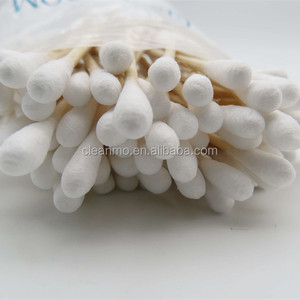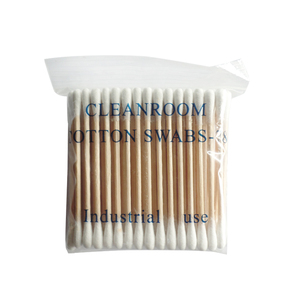(2463 products available)




































































































































































 Ready to Ship
Ready to Ship


















































Cleanroom cotton swabs are essential tools for maintaining the integrity of cleanroom environments. Several kinds of cleanroom cotton swabs are available for use in cleanrooms.
Standard Cleanroom Cotton Swabs:
Standard cleanroom cotton swabs are double-headed and disposable. They are packaged in quantities suitable for use in cleanrooms, where sterility is paramount. These swabs have long plastic handles and feature soft, fluffy cotton tips that are ideal for delicate cleaning tasks. The cotton tips are tightly wound to minimize the release of particles, making these swabs suitable for use in controlled environments where cleanliness is essential.
Foam-Tipped Cleanroom Swabs:
These foam-tipped swabs are designed for bulk cleaning and have a large foam tip. The foam tip is non-abrasive and can cover a broader area, making it suitable for cleaning larger surfaces or equipment. The foam used is low-particulate and non-contaminating, which means it does not shed particles that could compromise the cleanroom environment. The shaft of these swabs is often made of sturdy materials to withstand the pressure of cleaning without bending or breaking.
Pointed Tip Cleanroom Cotton Swabs:
Pointed-tip cleanroom cotton swabs have a tapered or pointed tip on one end and a regular cotton tip on the other. These swabs are ideal for precise cleaning and application of solvents, lubricants, or other chemicals. The pointed tip allows access to tight spaces, crevices, and intricate components of equipment that require detailed cleaning or inspection. This versatility makes them valuable tools for technicians and operators working in cleanrooms.
Large Foam-Tipped Swabs:
Manufacturers design large foam-tipped swabs for cleaning larger areas or more extensive equipment surfaces. These swabs have a wider foam tip made from low-particulate material. The foam tip is non-abrasive and can cover a broader area, cleaning larger surfaces or equipment. The shaft of these swabs is often made of sturdy materials to withstand the pressure of cleaning without bending or breaking.
Small Foam-Tipped Swabs:
Small foam-tipped swabs are ideal for detailed cleaning in cleanrooms. They have a small foam tip at one end, with a standard-size applicator on the other. The small foam tip can reach tight spaces, corners, and intricate parts of equipment that require careful cleaning. This makes them essential for applications where standard-sized swabs may be inadequate, such as cleaning filters, sensors, or small electronic components. Their size and foam material make them effective in removing dust, debris, or contaminants without leaving residues behind.
Before buying cleanroom cotton swabs in bulk, business buyers should consider the product's features and specifications and the manufacturer's reputation and credentials. Here are some pointers that might help in making the purchasing decision.
Product specifications
Take note of the size and quantity of the cleanroom cotton swabs. The size varies depending on the stem length and the cotton tip. Some manufacturers package the swabs in bulk, while others package them in smaller, manageable packets. Consider buying in bulk for businesses or kits that require a large quantity of these products. Take note of the cotton tip size, as it varies, depending on the application requirements. Some tips have tapered ends, while others have larger, rounded ends.
Product features
The main features of cleanroom cotton swabs are the stem material and the type of cotton. The stem can be made from wood, plastic, or paper. Plastic stems are more durable, while wooden stems are more absorbent. Consider the application requirements to choose an appropriate stem material. The cotton quality also varies, depending on the supplier. Some may use more synthetic fibers to reduce linting and absorb more liquids.
Manufacturers and suppliers
It is advisable to buy cleanroom cotton swabs from reputable manufacturers and suppliers. Check their certifications, which are proof of quality and authenticity. Read through their product reviews to get a brief history of their customer service, product quality, and delivery speed. Consider reaching out to their customer service and asking any pertinent questions regarding the product or their business in general.
Cleanroom cotton swabs are widely used in various applications, especially in cleanroom environments. Below are some tips on how to use them:
Preparation:
Prepare the surfaces and tools before using the cleanroom cotton swab. Make sure the area is clean and all necessary equipment is ready. This will ensure that the swab is used as efficiently as possible and that no new contaminants are introduced.
Protocol Adherence:
Follow all protocols required by the cleanroom environment. This includes wearing appropriate clothing, following cleanroom entry procedures, and adhering to all contamination control measures. Adhering to these protocols will help protect the integrity of the cleanroom and the equipment being cleaned.
Controlled Handling:
Handle the cleanroom cotton swab with care. Avoid touching the absorbent tip, as this can introduce contaminants. Instead, hold the plastic shaft or handle, which is designed to minimize contamination. Be conscious of the environment around you and avoid bringing the swab close to other surfaces or equipment that may introduce contaminants.
Minimal Contact:
When using the swab to clean or sample, make minimal contact with the surface. Light pressure is often sufficient to transfer material to the swab or clean the surface. Excessive pressure can crush the tip and release contaminants. Use a gentle, sweeping motion to collect particles or transfer materials to the swab.
Avoiding Cross-Contamination:
Do not use the same cleanroom cotton swab on multiple surfaces, as this can cause cross-contamination. Use a separate swab for each surface or piece of equipment that needs to be cleaned or sampled. Dispose of the swab immediately after use and do not reuse it, as this can also cause cross-contamination.
Dispose Properly:
Dispose of the cleanroom cotton swab properly. Follow all waste disposal protocols for the cleanroom environment. This may include placing the used swab in a designated waste container or disposing of it in a specific manner. Proper disposal helps to maintain the cleanliness of the environment and prevent contamination of other surfaces or equipment.
Safety is paramount when using cleanroom cotton swabs in a controlled environment. Below are some key factors to consider:
Controlled Contamination:
Cleanroom cotton swabs are manufactured and packaged in controlled environments to minimize the risk of contamination. This means that the tips and shafts of the swabs are free from dust, lint, and other particles that could interfere with cleanroom standards.
Non-Irritating Materials:
The materials used to make cleanroom cotton swabs are non-irritating, which means they won't cause harm to the surfaces or equipment being cleaned. This is especially important when working with delicate electronic components or medical devices where irritation can cause damage or malfunction.
Disposable:
Cleanroom cotton swabs are usually single-use, which helps prevent cross-contamination between surfaces and equipment. This is critical when working in controlled environments where even the slightest contamination can compromise the integrity of the cleanroom.
Environmentally Safe:
Some cleanroom cotton swabs are made from environmentally safe materials, which are safer for the environment and comply with various environmental regulations. This is an added benefit for those looking to adopt more sustainable practices in their cleanroom operations.
Q1. What are cleanroom swabs?
A1. Cleanroom cotton swabs are used in cleanrooms, which are spaces with controlled levels of contamination. These swabs have minimal linting and absorbency. The tips may be made of foam, polyester, or cotton, and the handles are plastic, wood, or aluminum. The materials used to make them do not produce particles or are minimal, which is essential in cleanroom environments.
Q2. What are cleanroom swabs used for?
A2. Cleanroom cotton buds are used for controlled cleaning in various applications that require high cleanliness standards. They are used for cleaning delicate and sensitive equipment in the semiconductor, pharmaceutical, and biotechnology industries. The swabs are also used for applying and removing adhesives and for sampling and testing in quality control processes.
Q3. What is the difference between regular and cleanroom cotton swabs?
A3. Unlike regular cotton swabs, which are used for general purposes, cleanroom cotton swabs are designed for use in controlled environments. They are packaged in a manner that prevents contamination before use. They are constructed from materials that either produce low levels of lint or none at all, while regular cotton swabs do not adhere to this standard.
Q4. What does lint-free mean?
A4. Lint-free means that the product will not leave behind any fibers or lint when used. Lint-free swabs are made from materials that do not shed particles, making them ideal for applications where contamination is a concern, such as in cleanrooms and for precision cleaning of electronic components and optical devices.
Q5. Are cleanroom cotton swabs the same as industrial swabs?
A5. While cleanroom cotton swabs can be used in industrial settings, their design and specifications target applications that require controlled levels of contamination. Industrial swabs may have features tailored to specific industrial processes, such as sturdier handles or larger tips.
The keyword "cleanroom cotton swabs" currently exhibits a relatively stable web search volume trend, with an average monthly search count of 10. Over the past year, there has been a noticeable decline of 50% in web search volume, although the three-month trend shows no change, indicating a recent stabilization.
Analyzing the detailed monthly data reveals some fluctuations. The web search volume peaked at 20 in December 2023 and October 2024, with the intervening months consistently recording 10 web searches. This pattern suggests a slight seasonal variation, with increases observed particularly in months ending with a '0' in the date.
The search trend for "cleanroom cotton swabs" demonstrates a clear dip over the year, followed by a plateau. The initial sharp decrease could be attributed to market saturation or shifts in consumer behavior, but the recent stabilization might indicate a return to normal purchasing patterns or an equilibrium in market demand. This analysis helps underline the importance of monitoring search trends to understand market dynamics and consumer interest levels accurately.